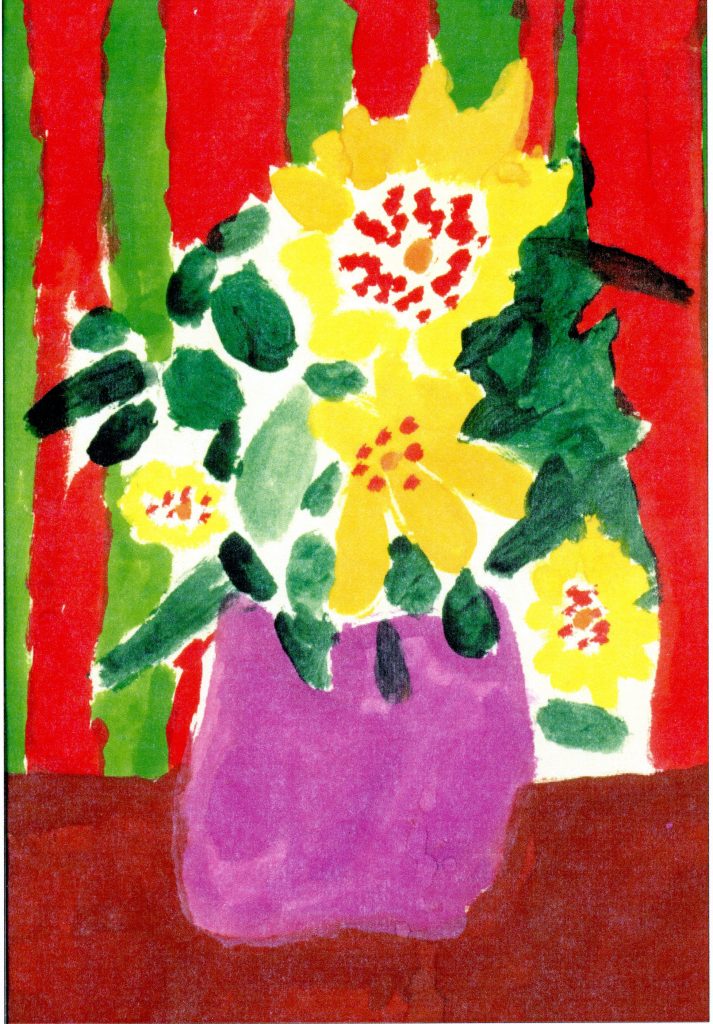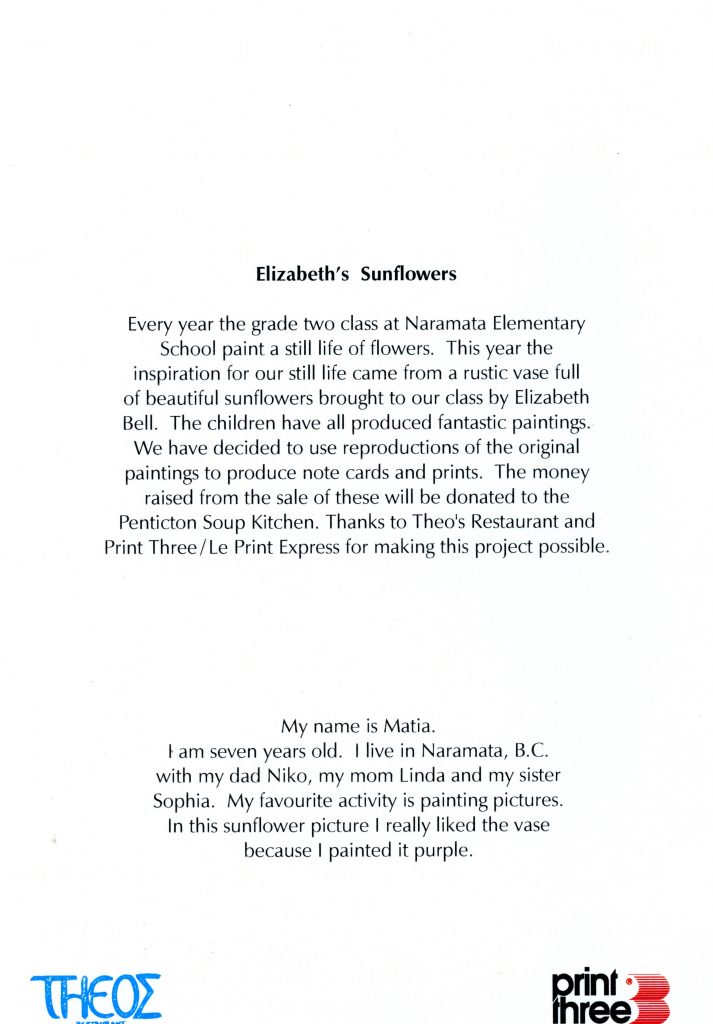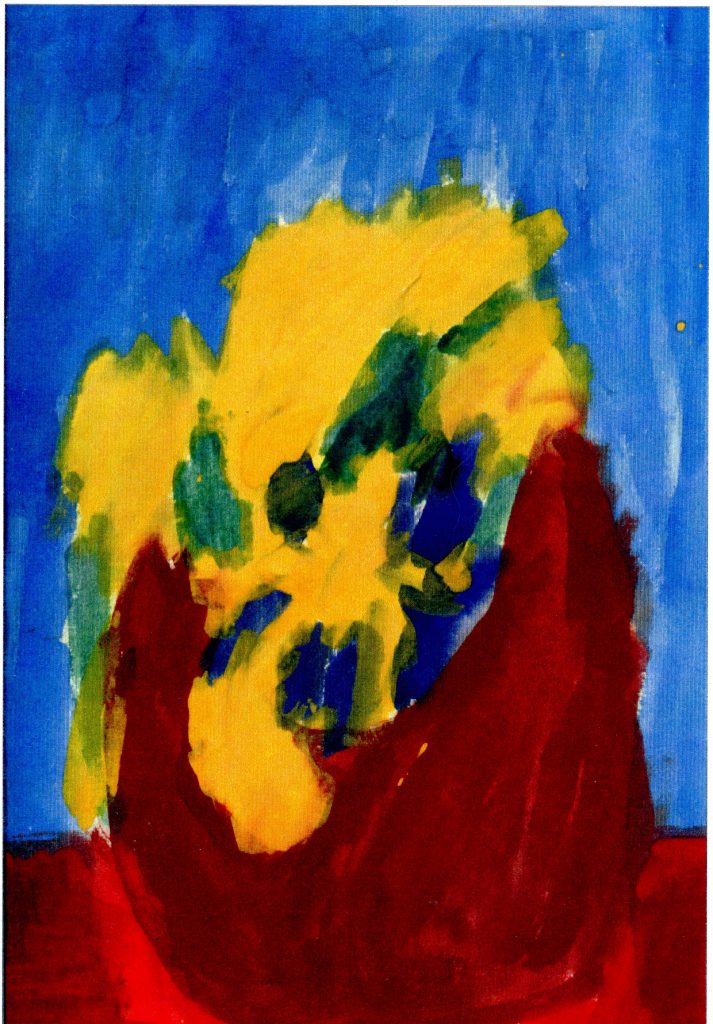
In the following school year the sunflower painting project branched out. Matia was in that new Grade Three classroom and it got me thinking about what other fun we could have. So, as well as inviting the students to create still life paintings of Elizabeth’s sunflowers, which would once again be displayed in the Theo’s courtyard, I invited the new Grade Three class to turn their sunflower paintings into greeting cards. I offered that my restaurant would pay for the printing of the greeting cards, and the cards could go on sale in the school and in the community as a fundraiser for wherever the students wanted to direct the money. We had some discussions in the classroom of what the money could be used for and it was decided that the students would raise money and donate it to an organization which needed some help, and in this case, they decided on the local Soupateria to help provide warm meals to the people they serve.
Once again, Elizabeth brought in a beautiful bouquet of sunflowers from her garden and each of the students set about painting magnificent still life paintings of the flowers in front of them. I appreciated hearing the teachers remind the students to take their time in observing the flowers and to look closely at all the rich details that make up a sunflower. There’s something magical watching children carefully taking paint to paper, patiently looking back and forth between flowers and paper, trying colors, mixing their palettes. What a treat to watch Matia and her friends create.

Once the paintings were completed, I took them to my friend Chris who owns a printing company in town called Print Factory. He scanned each of the paintings, and created a set of twenty five different greeting cards, each 4 inches by 6 inches printed on hard glossy stock, with the students artwork full frame in color on the front, blank on the inside for writing, and on the back, there was a short description about the project and a logo from Theo’s and a logo from his printing company. Above the sponsors logo was a biography which that student had written expressing their thoughts about their painting along with a little bit about themselves.

I delivered the cards to the classroom, along with matching envelopes, and the kids were super excited to see their cards and to show them to each other. About two dozen of each of the cards were printed so they would each have one to keep and the rest to sell. I think the big idea and the delight for me was to put a professionally produced piece, this greeting card, into their hands, and to see them make the connection that this real card, a card of the quality they might see for sale at a card store in town, came from their own talented hands. It was important to me for them to see that they were capable of creating this real life authentic object which was beautiful.
As well as the greeting cards, I asked Chris to print off a set of 11 inch by 17 inch colour prints from the artwork, so that the students could also sell posters of their sunflower paintings. Students began selling cards and posters at school functions as well as to family and friends. At Theo’s, we put up a display and sold cards to our guests. A local art gallery also started selling the cards, and soon the students had raised over seven hundred dollars in sales. The print shop did the printing at their cost, and I picked up that expense, so the seven hundred dollars in sales was all profit for the students to donate.
The original paintings were framed under glass and hung up in our restaurant’s bright courtyard. The students were invited down to Theo’s, as in the previous year, to see their paintings on display, to tour the restaurant from an artist’s perspective, to have a luncheon of new flavours amongst their artwork, and to have their portrait taken with their painting.
Before going to the restaurant, we all went to meet Chris at his printing company to learn more about how the paintings they had painted in their classroom had become greeting cards. As we entered the building, the students were surprised and excited to see a giant four foot wide and eight foot high colorful poster that had all of their paintings assembled together filling the printing store’s window, where people passing by each day could see and also learn more about their project.
Inside the store, Chris demonstrated how a picture was taken of their paintings by a scanner, how it produced a digital image, how it was assembled in a graphic design program with the students name and bio on his computer, how the giant printer printed it out on hard card stock, and how the blades of his paper cutter cut and trimmed the cards into the right size and then with the folding machine, created the final, wonderful cards that they had been given. So it was a little look at technology and the production process through the perspective of their own card project, and how all the equipment came together to support and create their goal of creating cards from their paintings.
After the tour and lunch at Theo’s, the group went down to the Penticton Art Gallery where the curator Geraldine gave them a tour of the gallery and showed them what other artists, like themselves, had been up to. She also talked about artists in our community, how they show their work, how they sell it and how important they were to creating a vibrant community by sharing their ideas and visions with others. She publicly thanked the students for their creative contributions to the community.
A few weeks before the field trip day, the students decided to donate some of their profits to a family of one of the students in the school. That students family was having a medical emergency and their community of Naramata was rallying together to raise financial assistance to meet the demands of their medical and travel expenses. The kids contributed as well, donating half their monies earned from selling the cards and posters. With the reminder of their money, they wrote a cheque to the Penticton Soupateria and delivered it in person after that visit to the art gallery. Inside the Soupateria facility they had a chance to tour the kitchen and see all the food being created and to see the tables and chairs being set up in the dinning hall for the dinner later that afternoon. The person who ran the program accepted the cheque, a photograph was taken with everyone, and the kids had a chance to see where their money would be used in the community, monies raised from cards created from sunflower paintings they had painted themselves.
I liked how the project had grown, in this small way, from hanging the artwork on the walls, to creating the cards. And I like how the kids responded to seeing their artwork becoming real life greeting cards as real as something they would see in a store downtown. I liked how they had not only had the luncheon trip to my restaurant, but how the nature of the card project naturally led into the tours of Chris’s printing shop, our communities Art Gallery and our local Soupateria. It seemed like a natural organic growth which evolved from the project, which enabled them to see their art in a public space and to learn a little more about our community itself.
I also liked that they might see the connection between themselves as artist and themselves as people who can create change in their communities, with the donation they made to the Soupateria, and with the donation they made to the family. Somehow I felt it was important that we give students opportunities for them to see themselves in this potential, as agents of change, even in grade three.

About six months later, Linda and I are in Vancouver visiting our freinds Kevin and Jan, and as we’re sitting down at their dinning room table, I notice the upright piano next to us, and prominently displayed on it, a greeting card from our project. Kevin saw me looking at the card, grabbed it, and showed it me, “Isn’t it great?” He said, “A friend of ours sent it to us from Naramata, their son painted it.” I smiled and said “I know, I saw him paint!”
Seeing that little still life masterpiece, gently placed in a state of prominence on the piano, discretely surveying our table of food and freinds, made me shiver. Considering these cards making their way from that little classroom in Naramata to freinds and family around the world felt very satisfying. I think satisfying that in my role as a small business owner in my community, as a parent of that school, that I was able to help bring to life a project that enabled a variety of connections to happen.
Sitting at their dining room table, looking at this little card with its beautiful sunflower in yellow and blue, I felt there was some kind of meaning to this project emerging which I was just starting to get a sense of. Somehow, I knew that this little project mattered.


